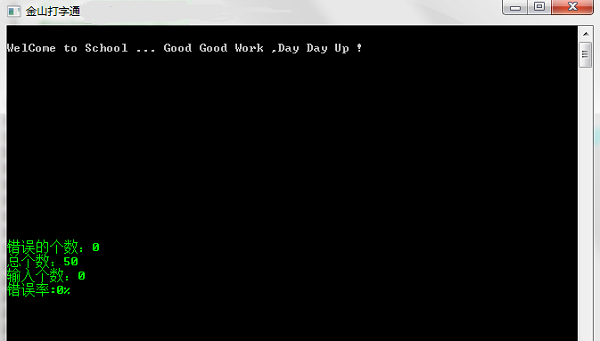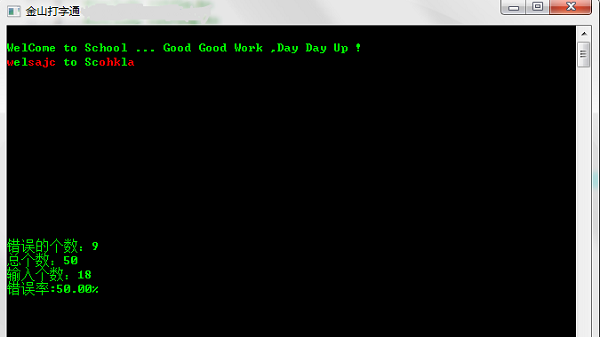#include <stdio.h>#include <string.h>#include <Windows.h>#include <unistd.h>#include <conio.h>#define NR(x) sizeof(x)/sizeof(x[0])//清屏#define ClearScreen() / system("cls");#define TITLE "金山打字通" enum{ LEFT = 1 , RIGHT , BACKSPACE , ESC , Char,};enum KEYBOARD{ ESC_KEY = 27, BACKSPACE_KEY = 8 , LEFT_KEY = 75 , RIGHT_KEY = 77};int iindex = 0 ;int max = 0 ; static int count = 0 ;char buffer[1024] = {0} ;int Get_User_input(HANDLE hOut,char *ch) ;void Show_string(HANDLE hOut,const char *text) ;//窗口初始化void HANDLE_init(HANDLE hOut);//定义设置光标结构体变量CONSOLE_CURSOR_INFO cci; //定义默认的坐标位置 COORD pos = {0,0};int main(void){ char *text = "WelCome to School ... Good Good Work ,Day Day Up !" ; char ch ; int ret ; HANDLE hOut; hOut = GetStdHandle(STD_OUTPUT_HANDLE); HANDLE_init(hOut); printf("/n%s/n",text); Show_string(hOut,text); while(1) { if(max >= strlen(text)) break ; ret = Get_User_input(hOut,&ch) ; if(ret == ESC) break ; Show_string(hOut,text); } //关闭窗口句柄 CloseHandle(hOut); return 0 ;}//窗口初始化void HANDLE_init(HANDLE hOut){ SetConsoleTitleA(TITLE); //获取当前的句柄---设置为标准输出句柄 //获取光标信息 GetConsoleCursorInfo(hOut, &cci); //设置光标大小 pos.X = 0 ; pos.Y = 2 ; cci.dwSize = 1; //设置光标不可见 FALSE cci.bVisible = 0; //设置(应用)光标信息 SetConsoleCursorInfo(hOut, &cci);}static int __Get_User_input(HANDLE hOut,char *ch) { char tmp ; int type = Char ; //关闭回显 pos.X = 0 ; pos.Y = 2 ; GetConsoleCursorInfo(hOut, &cci); cci.dwSize = 100; cci.bVisible = 0; SetConsoleCursorInfo(hOut, &cci); tmp = getch() ; switch(tmp) { case ESC_KEY : type = ESC ; break ; case BACKSPACE_KEY : type = BACKSPACE ; break ; case LEFT_KEY : type = LEFT ; break ; case RIGHT_KEY : type = RIGHT; break ; } *ch = tmp ; //打开回显 pos.X = 0 ; pos.Y = 2 ; GetConsoleCursorInfo(hOut, &cci); cci.dwSize = 100; cci.bVisible = 1; SetConsoleCursorInfo(hOut, &cci); return type ;}//获取用于输入 int Get_User_input(HANDLE hOut,char *ch){ int type ; type = __Get_User_input(hOut,ch); switch(type) { case Char : if(buffer[iindex] == '/0' ) buffer[iindex] = *ch ; else { memmove(buffer+iindex+1 , buffer+iindex , max-iindex) ; buffer[iindex] = *ch ; } iindex ++ ; max ++ ; break ; //case LEFT : if(iindex > 0) iindex -- ; break ; //case RIGHT : if(iindex < max) iindex ++ ; break ; case BACKSPACE : if(iindex > 0){ memmove(buffer+iindex-1 , buffer+iindex , max-iindex) ; iindex -- ; max -- ; } if(iindex == 0) { count = 0 ; } break ; case ESC : return ESC ; } return 0 ;}//显示和统计 void Show_string(HANDLE hOut,const char *text){ system("cls") ; printf("/n%s/n",text) ; int i ; int errno_Num = 0 ; for(i = 0 ; i < max ; i++) { if(buffer[i] == text[i]) { SetConsoleTextAttribute(hOut, FOREGROUND_GREEN | 0x8); printf("%c",buffer[i]); } else { SetConsoleTextAttribute(hOut, FOREGROUND_RED | 0x8); printf("%c",buffer[i]); errno_Num++ ; } } pos.X = 0 ; pos.Y = 2 ; cci.dwSize = 100; cci.bVisible = 1 ; SetConsoleCursorPosition(hOut,pos); SetConsoleCursorInfo(hOut, &cci); SetConsoleTextAttribute(hOut,FOREGROUND_GREEN | 0x8); pos.X = 0; pos.Y = 15 ; SetConsoleCursorPosition(hOut,pos); printf("错误的个数:%d", errno_Num) ; pos.X = 0; pos.Y = 16 ; SetConsoleCursorPosition(hOut,pos); printf("总个数:%d", (int)strlen(text)) ; pos.X = 0; pos.Y = 17 ; SetConsoleCursorPosition(hOut,pos); printf("输入个数:%d", max) ; pos.X = 0; pos.Y = 18 ; SetConsoleCursorPosition(hOut,pos); if(count == 0) printf("错误率:0%%") ; else printf("错误率:%.2f%%",((float)errno_Num)/((float)max)*100) ; pos.X = iindex + 1 ; pos.Y = 2 ; cci.dwSize = 100; cci.bVisible = 1 ; count = 1 ; SetConsoleCursorPosition(hOut,pos); SetConsoleCursorInfo(hOut, &cci); fflush(stdout);} 
